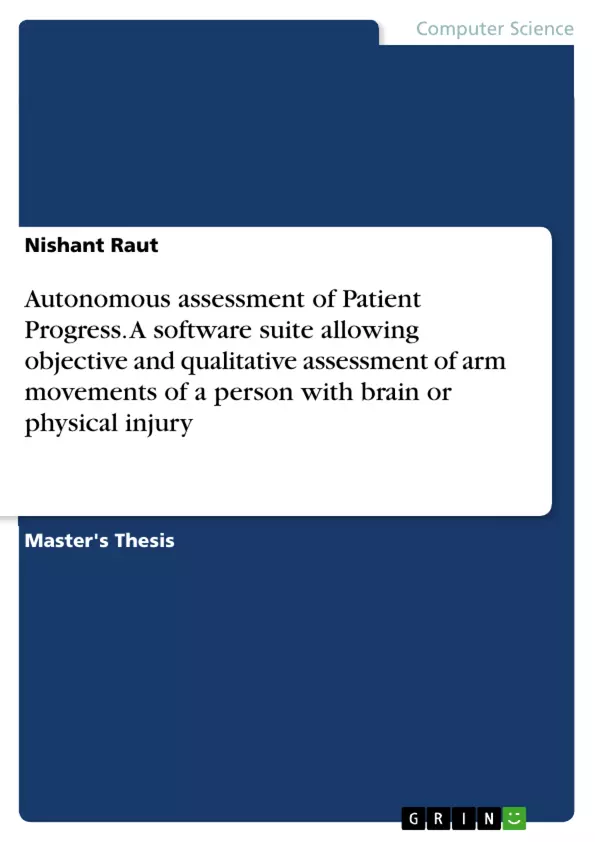This thesis presents an approach of developing FUGL-MEYER test using Microsoft Kinect. This method of developing the application for FUGL-MEYER test will change the measurement format from subjective to objective. This approach can solve the intertester reliability problem of the FUGL-MEYER test. Software is developed to calculate the different joint angles so that it can give measurements in objective format and data gets stored in text file in respective test folders.
Testing has been done with human skeleton to check the distance from Kinect which gives more accurate results with minimum deviation. This thesis also gives some future development ideas. The main aim of this study is to apply this approach in development of FUGL-MEYER test to enhance the current measurement strategy of the test.
Inhaltsverzeichnis (Table of Contents)
- CHAPTER 1: Introduction
- 1.1 Problem Statement
- 1.2 Aim
- 1.3 Objectives
- 1.4Thesis Outline
- CHAPTER 2: Background and Literature Review
- 2.1 Previous work in Neuro-Rehabilitation
- 2.2 Fugl Meyer
- CHAPTER 3: Requirement Specification
- 3.1 Purpose
- 3.2 System Overview
- 3.3 Analysis and Design
- CHAPTER 4: Implementation and Testing
- 4.1 Implementation
- 4.2 Measurement
- 4.3 Testing
- 4.4 Discussion
- CHAPTER 5: Conclusion
- 5.1 Summary of work
- 5.2 Future work proposed
Zielsetzung und Themenschwerpunkte (Objectives and Key Themes)
This thesis presents the development of a software suite designed to objectively and qualitatively assess arm movements in individuals with brain or physical injuries. The software aims to provide a standardized and reliable method for tracking and evaluating patient progress during neuro-rehabilitation.
- Development of an autonomous assessment system for arm movements in neuro-rehabilitation.
- Implementation of objective and qualitative measurement methods.
- Integration of computer vision and machine learning algorithms for movement analysis.
- Evaluation of the system's accuracy and reliability through testing.
- Exploration of the potential benefits and limitations of the software for clinical practice.
Zusammenfassung der Kapitel (Chapter Summaries)
- Chapter 1: Introduction This chapter introduces the problem of subjective and inconsistent assessment methods in neuro-rehabilitation. It outlines the aim and objectives of the thesis, which is to develop a software suite for objective and qualitative assessment of arm movements in patients with brain or physical injuries. The chapter also provides a brief overview of the thesis structure.
- Chapter 2: Background and Literature Review This chapter reviews existing literature on neuro-rehabilitation and existing assessment tools. It discusses previous work in the field and highlights the limitations of traditional methods. The chapter also provides an overview of the Fugl-Meyer Assessment, a widely used tool for evaluating upper limb function in stroke patients.
- Chapter 3: Requirement Specification This chapter details the requirements for the software suite, including its purpose, system overview, and design considerations. It outlines the intended functionality and features of the system, as well as the specific technical requirements for implementation.
- Chapter 4: Implementation and Testing This chapter describes the implementation of the software suite, including the details of the chosen technology, algorithms, and testing procedures. The chapter presents the results of the testing process, evaluating the software's accuracy and reliability in assessing arm movements. The discussion section analyses the findings and highlights any limitations or areas for future improvement.
Schlüsselwörter (Keywords)
Neuro-rehabilitation, arm movement assessment, computer vision, machine learning, objective assessment, qualitative assessment, software suite, Fugl-Meyer Assessment, patient progress, brain injury, physical injury.
- Quote paper
- Nishant Raut (Author), 2012, Autonomous assessment of Patient Progress. A software suite allowing objective and qualitative assessment of arm movements of a person with brain or physical injury, Munich, GRIN Verlag, https://www.grin.com/document/906580



